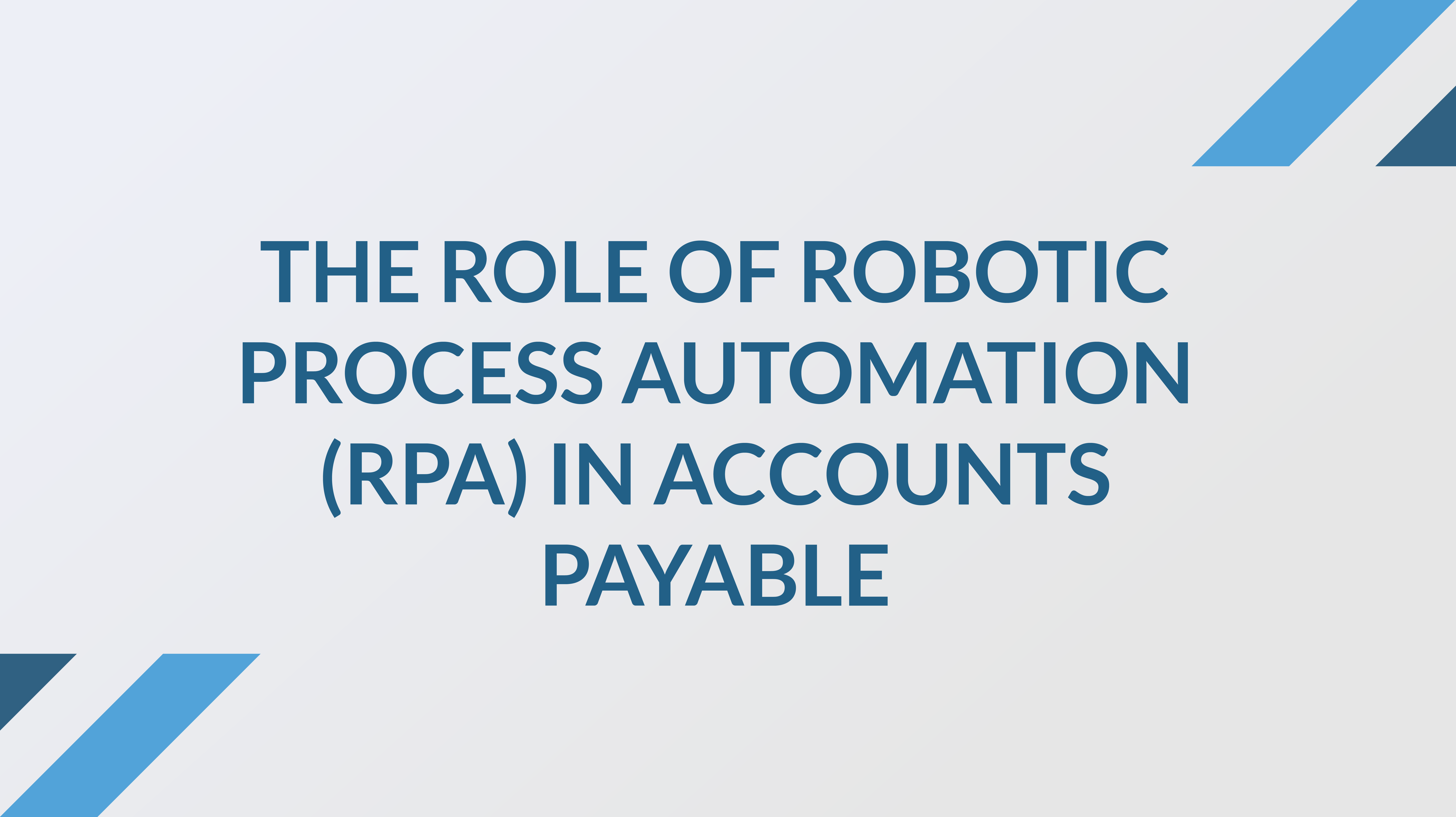Automated Accounts Receivable Programs: Cutting DSO by 30% in Six Months
In today’s economy, speed to cash is as important as speed to market. Companies that let receivables linger for 60, 75, or even 90 days are putting...
5 min read
April 9 2024
by
![]() Chris Cosgrove
Chris Cosgrove

How does robotic process automation (RPA) work in accounts payable, and what kinds of tasks can it manage? Here’s a primer for accounting and AP professionals.
To some, the phrase “robotic process automation” might sound like an action film scenario in which a robot comes in and takes over the planet. But never fear … RPA has nothing to do with actual robots in a physical sense, nor is it intended to replace the need for human oversight in business.
Robotic process automation is actually part of a wider ecosystem of software technologies that are transforming the way businesses receive, process, and manage data. And for accounts payable, these technologies are becoming game changers as far as task efficiency and productivity.
Robotic Process Automation (RPA) is a data recognition technology that processes repetitive, predictable computer-based tasks such as completing keystrokes, extracting data, and copying data between applications. In a business environment, RPA can do things like generate a response to a chat, complete data entry, process payroll—even extract order information from an email.
To put RPA into a more scientific perspective, it begins when a person inputs logic into a software that becomes a script, otherwise called a “bot.” As a result, the bot mimics a task within a business process, alleviating the need for a person to complete the task manually. The bot can function across one or more software applications, and when combined with AI and machine learning, it can use historical data and patterns to make rules about how to handle complex tasks.
The real beauty of RPA is that it’s able to complete all of its assigned actions in a fraction of the time it would take a human to complete the same actions. And while some have perceived the use of RPA as a threat to job security, the technology actually does quite the opposite: it benefits employees by freeing up time for them to pursue more complex, high value activities.
OCR is short for Optical Character Recognition, and this data recognition technology is able to pull text from image-based documents and then convert the information into digital data. It’s best used in simple image-to-text conversions since it doesn’t have the ability to mimic human processes like RPA does. When put together, however, OCR and RPA form an automation powerhouse.
It might be best to think of OCR as a technology that enables RPA. OCR analyzes patterns that make up a document’s letters and numbers, recognizes the document’s text, and then converts it all to an editable format. RPA works hand in hand with OCR by automating the document scanning process and uploading extracted data to software systems.
The popularity of RPA has increased dramatically in recent years as businesses look for ways to leverage technology in the midst of increasing operating costs and ongoing labor shortages. Combined with OCR and AI technologies, financial leaders are utilizing RPA to form end-to-end AP automation solutions for accounts payable departments.
Here are a few important tasks being streamlined:
Invoice Processing. Entering invoice data, matching, and coding to an accounting system are some of the more time-consuming workflows AP departments must handle each day. Besides the extra time it takes to organize, type, and process data, the potential for errors is always present—and once an error occurs—it can mean thousands of dollars lost.
Many AP professionals say that the average time required to process an invoice manually is around a month—from receipt of invoice and matching all the way up to approval and posting for payment. This timeline can be problematic because not only does it put departments at risk for late payments and late fees, but it also puts unnecessary stress on AP employees and vendors.
Once automation is introduced to invoice processing, however, the resulting time-cost savings is significant. Automation handles invoice capture, coding to the GL, 2- and 3-way matching, and approval routing. It’s even able to capture duplicate invoices, flag for missing invoices, and route to an appropriate handler when an exception is found.
Overall, with a good technology stack, some AP automation solutions like APSmart have been able fully automate up to 80% of invoice processing, from invoice capture to posting for payment
Payment Processing. When an invoice is authorized and ready to be paid, those responsible for making payments need to know due dates, payment instructions, and vendor contact information in case questions about the transaction arise. But when hundreds or thousands of payments are presented each month for processing and tasks are handled manually, it can be challenging to make payments accurately and on time.
In addition to these hurdles, many accounts payable teams are still remitting payments manually via paper check, which is expensive and carries an increased risk of fraud. Replacing manual processing with automated payment technology to make vendor payments gives AP employees real-time visibility into payment details and enables them to schedule and pay vendors automatically according to their preferred payment method. Not only that, but it also centralizes payments for a business, effectively eliminating unnecessary cost centers.
Automating accounts payable with RPA and other automation technologies is giving businesses the ability to eliminate a large percentage of manual processes while also giving financial leaders the capacity to view invoices and payments, reports, and records in real time.
Here are some additional benefits:
Improved Efficiency. A top priority for many businesses today is increased operational efficiency. RPA and automation technology play a big role in removing many of the inefficiencies that occur with manual AP processes including handling incidences of missing invoices, double payments, and data entry errors.
With a pre-configured invoice approval workflow, RPA and automation technology takes care of all the routing and moves invoices to each approval authority, giving them the option to approve or decline the action. Rules can even be set to remind the approval authority to take action or re-route the invoice to someone else as an alternative.
Better Relationships With Vendors. A couple good things about adding RPA and automation to an invoice payment process include improved visibility of payment status along with the opportunity to pay invoices in a timelier manner. Some AP automation solutions such as CloudX’s PAYSmart even allow businesses to offer a variety of remittance options including checks, ACHs, credit cards, and virtual cards.
Additionally, when an invoice is presented for payment, it gets prepared for payment based on pre-configured rules. So, not only are employees free from re-entering data every time a transaction needs processing, but they can also move away from the time-consuming task of manually cutting checks once vendors are on board with electronic options.
More Days Payable Outstanding (DPO). Making payments via credit card or virtual card means a business gains the ability to extend Days Payable Outstanding (DPO) and subsequently have more capital available in addition to increased cash flow.
Lower Incidences of Fraud. In accounts payable, fraud can take on many forms such as duplicate payments, fake vendor invoices, and ghost invoices. It can happen internally or externally and involve employees, vendors, or hackers.
Automation protects against fraudulent activities with its ability to seamlessly validate all documents for errors and omissions. It also sets up workflow rules that enforce the segregation of duties and grant full visibility of each invoice processing step.
Improved Compliance. Automated systems can be set up to meet specific rules such as approval handling, exception handling, and invoice payment. They can also be programmed to adhere to particular industry regulations and tax laws. Each transaction is tracked automatically and timestamped as well, creating a clear audit trail and giving financial leaders the ability to perform detailed monitoring and reporting of compliance status.
Potential for Cash Rebates. It’s possible for a business to gather valuable cash rebates of up to 1% per dollar of spend when virtual cards are used to pay vendors. Over time, these rebates can result in significant cash back simply for paying on time.
If you’re ready to increase efficiency and accuracy in your AP processes, simplify your payments, and make bigger steps in strategic growth, please contact CloudX today for a no-obligation demo of our APSmart and PAYSmart automation software solutions.

In today’s economy, speed to cash is as important as speed to market. Companies that let receivables linger for 60, 75, or even 90 days are putting...

Managing operational costs today often means balancing operational costs against tight margins, making it essential to join a group purchasing...